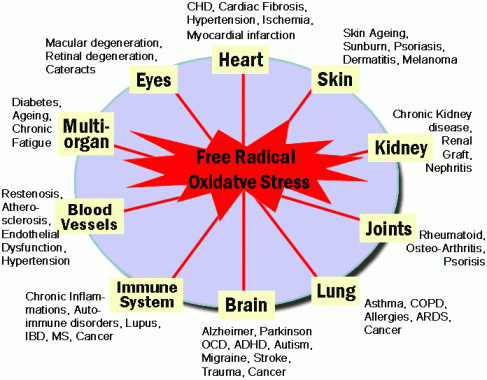What Is Oxidative Stress?

Oxidative stress has been implicated in the development and progression of numerous diseases, even psoriasis. Below figure illustrates the importance of oxidative stress that can affect all organs in our body and contribute to multiple health problems.Your body constantly reacts with oxygen as you breathe and your cells produce energy. As a consequence of this activity, highly reactive molecules are produced known as free radicals. Free radicals interact with other molecules within cells. This can cause oxidative damage to proteins, membranes and genes.
You have probably seen some rusty metal for example, like a tin can. I remember well when I used to spray paint cars for a living many years ago, how easily a steel car door panel would develop a fine film of rust even within hours. This is called “oxidation”, or the process of oxygen reacting with the bare metal. Oxidative stress is similar, the meal you had just a few hours ago is probably oxidizing in your digestive system and cells right now. Wouldn’t it be great if we could slow this “rusting” down inside our bodies? Well we can – with antioxidants. Thank goodness we get plenty of antioxidants from a healthy diet like The Psoriasis Diet, if we didn’t, we would literally “rust to death” in next to no time. In your body, the antioxidant process is similar to stopping an apple from browning. Once you cut an apple, it begins to brown, but if you dip it in orange juice, which contains vitamin C, it stays white. And some people actually do this, by eating junk and crappy diets until they literally develop accelerated aging, and ultimately death. An eating plan containing plenty of fruits and vegetables, whole grains and nuts can supply all the antioxidants your body needs, or does it? Are you getting enough in your diet?
Oxidative Damage Causes Disease

Oxidative damage has been implicated in the cause of many diseases such as cancer and Alzheimer’s and has an impact on the body’s aging process. External factors such as pollution, sunlight and smoking also trigger the production of free radicals. The presence of too many ROS (Reactive Oxygen Species) otherwise known as “free radicals”, leads to oxidative damage to the molecules in our cells including lipids, proteins and DNA, and this in turn can destroy cell function. In this situation our body is under oxidative stress. Oxidative stress leads to loss in cell function and eventually to cell death, and contributes to loss in organ function.
This process leads to the development of most chronic diseases and exacerbates existing chronic conditions like psoriasis.A free radical begins to search out other free radicals and then starts a chain reaction that occurs at a frightening speed. In a recent publication by Caroline Bay who worked for the Committee on the Public Understanding of Science of the Royal Society in the UK, the author states that some free radicals react at a rate of more than 6 x 1021 billion molecules per second. Our bodies can, therefore, be exposed to billions and billions of damaging free radicals on a daily basis. No wonder that people who live for many decades start to develop degenerative diseases and other negative effects of aging.Clinical research has shown that a good quality antioxidant dietary supplement can reduce oxidative stress in your body. You will be particularly interested in knowing about oxidative damage if you have psoriasis, and reducing oxidative damage with antioxidants makes a lot of sense if you want to reduce the damage done to your body on a molecular level
Reactive Oxygen Species (ROS)
OK, so here comes some technical information you may find interesting. Some people who read this will probably “switch off”, and click to another page, whereas others will find the information most useful.Reactive oxygen species are small molecules that include oxygen ions, oxygen free radicals, and peroxides, both inorganic and organic. These molecules are highly reactive due to the presence of unpaired electrons. ROS form as a natural byproduct of the normal metabolism of oxygen and have important roles in cell signaling. However, during times of disease, exercise, or environmental stress (e.g. smoking, sunlight or heat exposure) ROS levels can increase dramatically, which can result in significant damage to cell structures. This accumulates into the situation known as oxidative stress (see above). ROS are also generated by exogenous (external) sources such as ionizing radiation.Now you know why sunlight can be damaging if you have too much of it.Cells are normally able to defend themselves against ROS damage through antioxidant enzymes (the most common are superoxide dismutase, catalase, glutathione peroxidase), and small molecule antioxidants such as vitamin C and E, uric acid, and glutathione. Similarly, polyphenol antioxidants, the major class of antioxidants, assist in preventing ROS damage by “scavenging” free radicals.ROS have positive and negative effects on cell metabolism. Positive effects where ROS mediate functions of normal cell metabolism include the induction of host defence genes and mobilisation of ion transport systems, and roles in redox signaling. Negative effects of overproduction of ROS are implicated in many cardiovascular, inflammatory and neurological diseases. Generally, harmful effects of reactive oxygen species on the cell are most often:
- Damage of DNA.
- Oxidations of polydesaturated fatty acids in lipids (lipid peroxidation).
- Oxidations of amino acids in proteins.
- Oxidatively inactivate specific enzymes by oxidation of co-factors.
